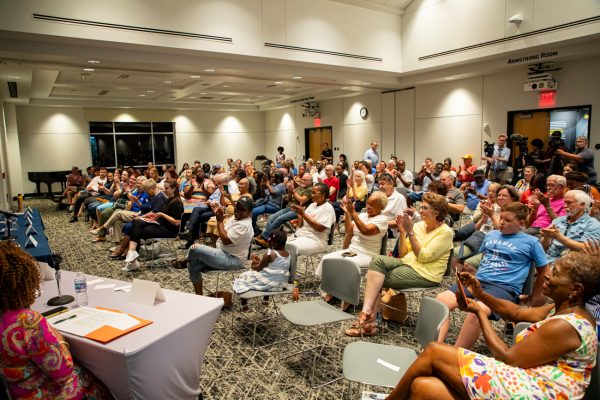Trigger warnings: Faculty, staff learn at panel discussion
Some educational videos can be horrid. At least one was shown at Wichita State.
“These are some ugly scenes,” Greg Meissen, WSU psychology professor, said he tells his students before watching Stanley Milgram’s controversial study unfold on video. “This is not about the people — it’s about a powerful setting that brought out the worst.”
Milgram’s famous study of obedience to authority put many study participants in situations in which they were continually encouraged by a researcher to administer increasing levels of shocks to a person with a possible heart condition whenever he or she incorrectly answered a question.
Meissen, community psychology doctoral coordinator, said he never thought of his description of the video as a trigger warning.
A panel discussion earlier this month was hosted by the Tilford Commission and the Office of Academic Affairs at WSU, with the purpose of providing faculty and instructors an opportunity to talk through the use of trigger warnings. It has become a controversial classroom issue recently, said Jean Griffith, panel organizer and moderator.
Trigger warnings started within Internet communities for the primary benefit of people with post-traumatic stress disorder, according to Kate Manne of The New York Times.
The warnings were made to flag content dealing with traumatic events like military combat or child abuse. Internet-users could then decide whether or not to view the material.
Popular social forum websites, like Reddit, use trigger warnings to warn users of content with blood and gore, or content that may not be safe to view at work.
The panel at WSU informed faculty and staff about whether they should issue trigger warnings in class syllabi and in what scenarios they should do so, Griffith said.
The participating panelists that led the discussion were Angela Demovic, assistant professor in anthropology, Shauna Millar, bachelor’s of Social work Director, Maureen Dasey-Morales, director of the Counseling and Testing Center Maureen and Mary Stolz-Newton, assistant director of Wichita Area Sexual Assault Center.
Alicia Sanchez, director of the Office of Diversity and Inclusion, attended the discussion and said trigger warnings make people aware of sensitive information based on personal experiences.
Sanchez said the panel initially focused on sexual assault, but the discussion widened and they acknowledged that many different things can trigger people, including racism, sexism, homophobia, Islamophobia and many other “- isms” and phobias.
“When I went in I was like, ‘Well absolutely, why wouldn’t you have a trigger warning?’” Sanchez said. “But, [the discussion was an] opportunity to see the other side of things.”
An instructor at the discussion talked about how she had shown an award-winning film without using a trigger warning beforehand and a student commented on the language of a specific scene, so she decided to provide a trigger warning the next time, Sanchez said.
“But then what happened was the discussion after they saw the film was focused on that [content] and it took away from what she was trying to accomplish,” she said.
Sanchez said she noticed the panel consisted of only women and wondered if male faculty members would have different thoughts or feelings toward trigger warnings.
“I would have appreciated that different perspective,” Sanchez said.
Griffith, Tilford Commission coordinator and English professor, said she summarizes texts before having students read them in her class because she teaches highly upsetting material at times, like the lynching of African Americans in the South.
“You have to teach that kind of material with great sensitivity, both to the students in your class and to the victims who endured it,” Griffith said. “Not teaching this material is not an option for me, though. My goal is to help students understand written texts in a way that helps them understand themselves and the world they live in a little better.”
The Milgram study showed the power of authority, even in a situation where the participants had objections to continuing. Sixty-five percent of participants went on to administer the full level of shocks (450 volts), which was labeled “XXX” on the shock generator.
“Trigger warnings have taught me to be more thoughtful,” said Meissen, the psychology professor. “It has caused [professors] to think and remember that they are a powerful figure in terms of sharing information.”
Meissen did not attend the panel discussion, but said he was already familiar with the national discussion on trigger warnings.
He had already heard of articles like “The Coddling of the American Mind,” in which authors insinuate that recent changes in colleges and universities regarding the ideas of trigger warnings and microaggressions could lead to an increase in college student anxiety.
The article cited a 2013 task force at Oberlin College in Ohio that released an online resource guide for faculty. The guide recommended that topics such as classism and privilege, among others, warranted trigger warnings and suggested these be avoided completely in the classroom unless they contributed directly to course goals.
Meissen said arguments like this on the national level are problematic because they’re arguing from extremes.
“I don’t think we’re going to coddle American college students,” Meissen said. “I don’t think they will stand for that, honestly … We’ve got to give more credit to students.”








